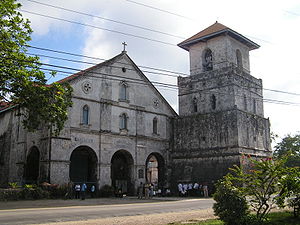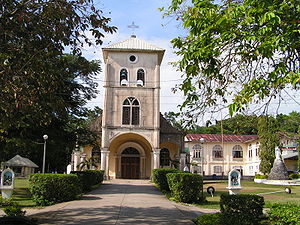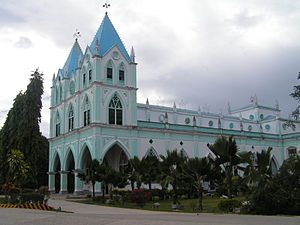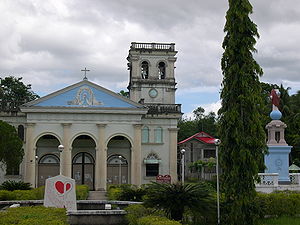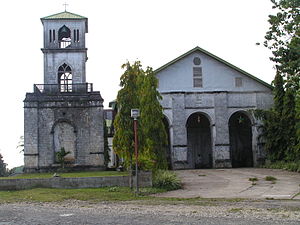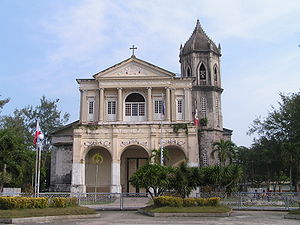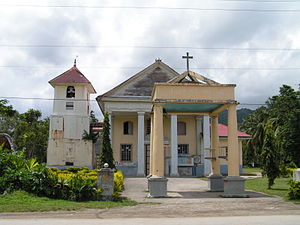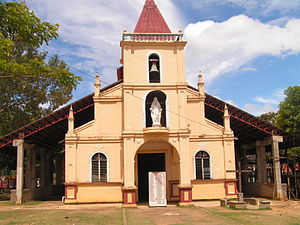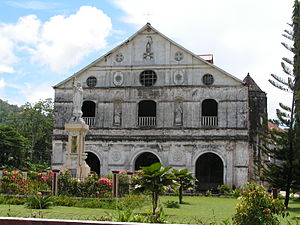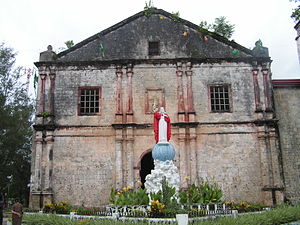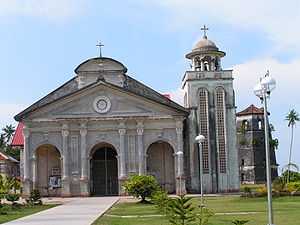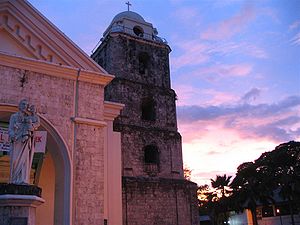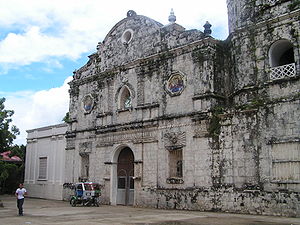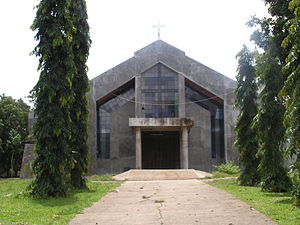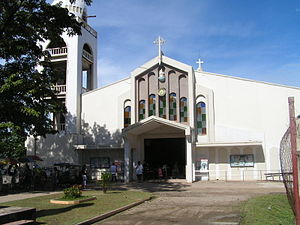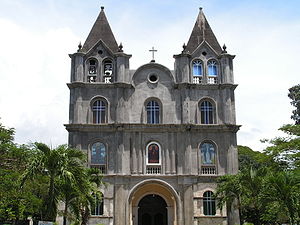- Churches in Bohol
-
Bohol, in the Philippines, has a number of very old churches, dating back to the early years of the Spanish colonization of the island.
Alburquerque
 Roman Catholic Church, Alburquerque, Bohol
Roman Catholic Church, Alburquerque, Bohol
Sta. Monica Parish
Boholanos call the town "Albur." Located along the highway is the church complex built on a low knoll. The Albur parish was established in 1869 after being separated from Baclayon, Bohol. An 1886 reports indicates that the church was built of light materials, however, the convento described as "de grandes dimensiones" was already standing. This way made of rubble, wood and tabique. The date of the construction of the church is uncertain, although, the generous use of reinforced concrete for the façade and the bell tower (which is integrated into the façade) indicates that the church was either being built or renovated in the 20th century. The church interior has been renovated. The large convento to the side of the church is connected by a bridge to the church. The whole complex is harmonized by a series of arches that link church, bridge and convento.
Anda
Anda is located in a peninsula that juts southwest. In this peninsula prehistoric sites have been discovered, one intriguing site yielded countless jawbones of pigs, carefully arranged. It was probably a ritual site, considered by the National Museum of the Philippines as an important archaeological site. The town was formerly called Quinale. Renamed Anda in honor of Simón de Anda y Salazar who resisted British occupation in 1762-64, becoming governor general in 1769, the town was created in 1876 and the parish in 1885. The Recollects were in charge of Anda until 1898, and by special request of the people returned in 1902 until finally leaving in 1937. The town was burnt by American after revolutionaries but the church was spared because of the pleas of the parish priest.
Heritage site: The church faces the beach, separated from it by a wide-open field. An older tabique church, probably the same one reported by Redondo (1886, 183) is said to have stood slightly across the convento. The change in colonial government in 1898 stopped the collection of material for a new church, begun as early as 1886, however in 1926 the church was completed under the direction of Fr. Carlos Ortuoste. The church is cruciform with a plain and austere façade enlivened by doors and windows. The interior however is a pleasant surprise with the colorful ceiling paintings by Ray Francia, the retablos the use Greco-Roman motifs, and the Art Deco confessionals. The adjoining convento was built in the 1880s and completed a decade later.
Antequera
The Nuestra Señora del Rosario parish of Antequera was founded in 1880. The church by this date was of tabique pampango and other light material. The present church at Antequera is new and unremarkable but people go to Antequera to experience a different kind of heritage: traditional basketry. Basketry is an ancient art form, archaeologists theorize that basket making preceded weaving. Most exquisite baskets found in the Visayas and even in Luzon, come from Bohol. Every conceivable forest material is made into baskets which are available wholesale or retail at the Sunday morning market at Antequera.
Baclayon
The Church of Our Lady of the Immaculate Conception in Baclayon is considered to be one of the oldest churches in the Philippines. It is one of the best presevered Jesuit build churches in the region, although in the 19th century, the Augustinian Recollects added a modern facade and a number of stone buildings that now surround the church. The first Spanish missionaries or doctrineros in the region, Fr. Juan de Torres and Fr. Gabriel Sanchez, first settled in Baclayon in 1595. Shortly after their arrival, a visita was erected on the spot. Although Baclayon was the first seat of the Spanish Jesuit missionaries, fear of Moro mauraders soon forced them to move their headquarters more inland, to Loboc. Only in 1717, Baclayon became a parish, and construction of a new church commenced. Some 200 native forced laborers constructed the church from coral stones, which they took from the sea, cut into square blocks, and piled on to each other. They used bamboo to move and lift the stones in position, and used the white of a million eggs as to cement them together. The current building was completed in 1727. The church obtained a large bell in 1835. In the Baclayon church is a dungeon, which was used to punish natives who violated the rules of the Roman Catholic Church.
Next to the church is the old convent, which also houses a small museum with centuries-old religious relics, artifacts and other antiquities, dating back to the 16th century. Included in the collection are an ivory statue of the crucified Christ looking towards heaven; a statue of the Blessed Virgin, said to be presented by Queen Catherine of Aragon; relics of St. Ignatius of Loyola, old gold embroidered ecclesiastical vestments, books with carabao skin covers, and librettos of church music written in Latin on sheep skins. Here you can also find the cuadro paintings made by the Filipino painter Liberato Gatchalian in 1859.
Baclayon is some 6 km east of Tagbilaran City. Catch a bus or jeepney in Tagbilaran, going into the direction of Baclayon. You may also find a tricycle willing to bring you there. Inmaculada Concepción Parish
The mission of Baclayon was established by two Jesuits Juan de Torres and Gabriel Sanchez who arrived in Bohol on 17 November 1596. They came from Cebu. Torres reports that he could not find a decent place to celebrate Mass, there wasn't even a serviceable table in the dwelling they stayed in. The Jesuit convinced the inhabitants to build a church, which they accomplished in no time. This was most likely a bamboo and thatch church. Baclayon served at one time as the residentia or center of the Bohol missions, where the superior resided. Baclayon was one of two towns that did not join the Diwata revolt (1621), remaining steadfast in the Christian faith.
Despite claims that the present stone church in Baclayon is the oldest in the Philippines, evidence places the construction of the church to 1727. The belief that the church was built in 1595 may have come because of a 19th century report by the Recollects that the mission was founded in 1595; but the same report lists two other dates 1593 and 1594. The date 1595 inscribed on the church façade is a later addition.
The adjoining but separate tower may have been started by the Jesuits, but it was completed during the administration of the Recollects, ca. 1777 as a stone inscription on the tower indicates. The inscription was recently defaced. The church complex was fortified with a wall built by the Jesuits. The walls' coral stones were used by the Recollects when they built a new wing of the convento in 1872.
Heritage Features: The church has two facades: an inner one which is Classical in inspiration, and outer one built in the 19th century by the Recollects is a portico decorated by three arches. The addition of porticoes to the façade seems to have been a style prevalent in Bohol and Cebu during the 19th century. Porticoes are found in Loay, Loboc, Cortes churches in Bohol, and Talisay, Recolletos, in Cebu.
The green and gilded altars are the focal point of the interior. They are exuberant versions of Baroque popular during the 18th century. Although the main retablo displays saints of Recollect devotion, the retablo itself traces to the Jesuits whose emblem and motto "Ad majorem Dei gloriam" surmounts the main altar. In the nave are found two benches carved in low relief. One features genre scenes: a goat tied to a tree, a coconut, nipa grove, and a man in stocks. A painting of the Ascension, Church Fathers and San Vicente Ferrer are found in the nave. These date to the 19th century.
The church had a pipe organ installed in the 1800s but now in disrepair. The choir and organ loft are decorated with cut out designs. The painting on the stucco finish of the church is of recent vintage (1996) and does not conform to the style and period of the interior.
Behind the church and convento are remnants of a fortification. Oral lore identifies some structures as horse stables, a kitchen, and a jail.
Baclayon started the trend in Bohol of establishing parish museums. The amount of liturgical material preserved in Baclayon is impressive. The church inventory books have helped in dating some pieces. In Baclayon cantorals (large handwritten music books) was found the Misa Baclayana, a musical setting for the Mass which has been revived and is part of the repertoire of the Loboc Children's choir. Permission from the parish is needed to see the museum, which is generally locked for security reasons.
Balilihan
The town and parish of Balilihan were from Baclayon in 1829, to make room for Dagohoy’s followers after the revolt, which lasted eight decades, were put to an end by a massive assault by Spanish troops from Cebu. The Recollects administered the parish until 1898. Although Redondo (1886, 177) reports the presence of a tabique church, the present church was probably completed in the early 20th century. The church mentioned by Redondo and renovated in 1889 was razed to the ground by American troops.
Heritage Site: The church of poured concrete has a nave divided into three aisles, a portico in front of the façade and a bell tower in front of the portico. The cruciform church is dedicated to Nuestra Señora del Carmen and has a squat octagonal cupola. The interior is embellished with paintings by Ray Francia, and has altars that combine Corinthian columns, neogothic spires and crockets, Baroque volutes and Art Deco open work. A veritable summary of 200 years of style.
On a hill overlooking the plaza is a much older structure. Constructed in 1840 of cut coral the Balilihan bell tower stands at strategic position, which made it a useful sentinel of the Abatan River. Thus it may have function both as a watchtower and as a bell tower.
Balilihan Watchtower
Nuestra Señora del Carmen Parish
Built in 1840 and located on a hill beside the church, the tower located about 20 kilometers upstream of the Abatan river also serves a watchtower against marauding bands. The church located at the foot of the hill is new, although the parish was founded in 1829.
Heritage features: Rising to four stories, with no clear divisions between floors, the quadrilateral bell tower used to be sheathed with cut coral. Its fenestrations are few concentrated mostly on the uppermost floor, where the arched opening are decorated by scroll work and floral designs. The whole structure has a hip roof with wide overhangs, supported by carved corbels. The structure had a tile roof but like the rest of the tower is in disrepair. The bells of the tower have been removed and are in a new bell tower beside the church at the foot of the hill.
Calape
The Calape church is gothic-inspired.
The town is named after type of rattan, called locally kapi or kalapi. Both town and parish dedicated to San Vicente Ferrer were founded in 1802. However, the settlement was already being served by priests from neighboring town of Loon before this date. In 1829, remnants of Dagohoy’s followers, some 1500 were coxed to settle in the area. The Recollects took charge of the parish until 1898 when it was turned over to the seculars. An old tabique and wooden church was replaced by one in the neogothic style commenced in 1933 and completed two decades later in 1954.
Heritage Sites: Calape church is a good example how colonial styles persisted even if the Spaniards who promoted them had already left. Jose (2001, 34) describes the church as the “epitome of Bohol Gothic.” All of the structure is basically a lintel and post type, gothic features like lancet arches, rose window, spires and crockets are merely decorative. The pediment has a rose window although it functions as an ornament rather than a real opening to the church interior. A typical Bohol feature, but definitely not gothic, is the portico built in front of the façade, an extension of the choir loft. Gothicizing elements are found in the interior on the altars and event the confessionals. The transept is an addition to the original plan and is rather narrow. The church is attributed to two builders, Eliseo Josol y Villamayor and Rosalio Real y Oppus, were said to have been shown a picture of the Santo Domingo church in Intramuros, which they used as a model.
A historic bell dated 1690 and dedicated to St. John the Baptist by Bachiller Juan Alfonso Ruiz, is found in the bell tower. This bell came from the defunct Parian parish in Cebu, ordered dissolved, resulting in the demolition of the church in 1878-79.
Candijay
Clarin
Originally named Can-ogong, Clarin was established as a parish in honor of St. Michael the Archangel in 1924, after being a visita of Inabanga in 1852, and of Tubigon in 1881. Clarin was established a town in 1921 and named after Aniceto Clarin, Bohol’s first civil governor. The Recollects administered the parish from 1927–37 and were succeeded by the seculars. The church traces to the 1920s when Recollects built over a provisional church raised in 1924. In 1952, the roof and walls were raised and in 1955 another register was added to the bell tower. This was damaged in an earthquake of 1996 and had to be torn down and replaced with a more stable structure.
Heritage Site: The church made of poured concrete continues the neogothic style prevalent in Bohol with a central tower in front of the façade, which serves both a bell tower and portico. Lancet windows, finials, and other Gothic motifs are expressed in cement.
Corella
Cortes
Known by the ancient name Malabago, Cortes was already being served by priests from Maribojoc. Established as an independent parish in 1793 or 94, it was renamed Paminguitan. The town was established later, probably in 1862. The town was renamed after the Spanish conquistador, Hernan Cortes. The parish was dedicated to the Santo Niño. Although the Recollects who served the parish from its inception until 1898 had begun to build a church in 1880, the bell towers upper register was not completed until the 20th century.
Heritage Site: Perched on the slope of a low hill, the town of Cortes gives its church a dramatic setting. Shaped as a cruciform, this sedate building is of cut coral has an octagonal crossing tower. Floral carving frame the doorway, and a light pink plaster can still be seen suggesting that the façade was more colorful than it is now. The interior is dominated by the painted ceiling done by Ray Francia. The main retablo has twisted Solomonic columns and profusely carved flanges in the Baroque idiom, a contrast to the otherwise revivalist line of the church.
Cortes Church
Santo Niño Parish
The Cortes church is located on top of a hill. Like most Bohol churches, the Cortes church has a portico in front of an older façade.
Dauis Church
Another beautiful church in Bohol is the Church of Our Lady of the Assumption in Dauis, Bohol, on the Island of Panglao. It is located not far from the bridge that connects Panglao with Bohol. The church was founded by the Jesuits Fr. Diego de Ayala and Joseph Gregorio. The church is built in a mixture of styles, influenced by both Byzantine and Romanesque architecture. Inside, on the ceiling, are some impressive frescoes painted Ray Francia in 1916. Lito Arraya renovated the building in 1970. The church's patron saint, the Virgin of the Assumption, is said to possess miraculous powers. An old legend relates that once, when the town was invaded by pirates, the people of Dauis locked themselves into the church. However, they soon ran out of provisions and water. Then a miracle occurred: a well appeared at the foot of the altar. This same well is still the main source of water for the people living close to the church, and, although the well is only a few meters from the sea, the water is absolutely fresh. The water is said to have healing powers.
This is one of Bohol’s beautiful churches, which has retained its Spanish architecture although it has a semi-modern façade. The church is a nice three kilometer walk from Tagbilaran City. Alternatively, visitors may catch a tricycle or jeepney to bring them across.
Dimiao
The San Nicolas Tolentino parish is in Dimiao, Bohol. The date of the parish's foundation is uncertain, although by 1750 there are records of baptism in the parish. The church may have been built toward the later half of the 19th century. The structure of cut stone is cruciform, though its transept is short. The façade can be described as Neobaroque. Although classical overall, shallow reliefs of flowers arranged as vertical bands decorate the façade. The façade is flanked by twin octagonal towers.
Its heritage features are described as follows: The church interior is simple, coming to a focus at the Neoclassical altars. One of the side altars is missing. The convento is located behind the church and is now a school. Beside the church are the ruins of what appears to be cemetery and two mortuary chapels. Archaeological excavations in the area have uncovered very little remains, probably the site was never used.
Duero
Named after a mighty river that traverses northern Spain and Portugal, Duero was created a town in 1862, from barrios of Guindulman and Jagna. It became a parish in 1863 with the advocacy of Santa Filomena, however, it is present patron is the Immaculate Conception. The Recollects administered the parish until 1898, returning in 1902 and finally leaving in 1937. Construction of the church began under the first Recollect pastor Fray Lorenzo Hernandez (1863–70) who collected wood necessary for construction. The church was completed in 1874 and the convento around the same era during the term of Fray Francisco Castellano (1871–86). The church’s cogon roof was replaced with zinc sheets in the late 19th century. The church and adjoining convento were the only structures saved from destruction when American troops set the town on fire in October 1901.
Heritage site: Designed in the “Greek temple” revival style it one of the few churches in such style (Anda, Dumaguete, and Malabon designed by Luciano Oliver in 1861 among them). But what sets Duero apart is the generous use of wood. Indeed, it is one of the few surviving “gems of Philippine architecture in wood” (Jose 2001, 50). Although Fray Isidoro Musitu (1891–97) had the mortar covered with cement, the tabique walls enclosed in zinc sheets and the interior embellished, much of the original structure still exists. Originally, the walls were made of double walls of wood planks, with planks set vertically in the inner wall and horizontally in the outer.
Like the church, the bell tower a separate structure joined by a bridge has a lower story of mortar and an upper story of wood and zinc sheets. The 1920s zinc sheets inscribed “Wolverhampton” are still in place. The interior is a symphony in wood: wooden floors, wooden ceiling originally painted with an artesonado design (coffered ceiling) with alternating rosettes and concentric circles. The crossing’s ceiling is quite shallow with a carved pineapple dangling from its center whence a chandelier hangs. The wooden retablos are in neoclassical style.
Garcia Hernandez
Originally known as Sinugbuan because it was populated by Cebuanos, the town was established a visita of Jagna in 1841 and in 1844 a chapel was built. Jagna, the mother parish, had a retablo and a painting of St. John the Baptist, the patron installed in 1848. In 1857 a more substantial church was built, and in 1858 the town was established and a year later the parish. During this time the town was renamed to honor two Recollect priests who were instrumental in securing the necessary authorization for this development: Fray Jose Garcia of Loon and Narciso Hernandez of Guidulman. In 1870, the town site was transferred to the neighboring barrio Manaba, and the former site came to be known as Lungsod-daan. The Recollects remained until 1898. Americans burned the town in 1901.
A heritage site, the present church was commenced in 1880 and completed in 1896, replacing an earlier church. However, an earthquake in 1990 damaged the façade. The rebuilt façade is in a completely new style unsympathetic to the older church. The interior has a main nave flanked by side aisles. A Doric frieze runs across the church. The device of the frieze and fluted columns are used in the retablo mayor.
Guindulman
Dedicated to the Nuestra Señora de la Consolacion, Guindulman located on the banks of the Tabajan River was organized as a town to receive the returning bands of Dagohoy’s followers who had fled to the mountains after his revolt. The Recollects inaugurated the parish in 1798 remaining there until 1898, and returning in the early 20th century to remain until 1937. The town was put to the torch by Americans during the Fil-American War and by the Japanese during World War II, the church and convento, however, were spared.
Fray Antonio Fernandez, the first Recollect parish priest (1798–1807) built the first church but it was burnt during a raid by Dagohoy’s followers in 1829. A new church was built in its place and is mentioned in Redondo (1886, 184) as of modern construction. This neoclassical church survived to the 20th century but now stands in ruin behind the present church. Another church was begun in 1881, a decade after a new convento was completed (1877). The church took more than half a century to finish culminating in 1950.
Heritage Site: The present church is of mixed material, the lower register of coral stone and the upper of concrete, reflecting the long time it took to complete it. A portico was built in front of the façade and supports a balcony. The church interior is relatively bare, with ornaments from the 1950s and 60s. The 1877 convento beside the church is separated by a road and is now used as a school.
Inabanga
Located on an elevated area beside the banks of the Inabanga River, a mission was founded in the place by the Jesuits in 1596. Like Talibon, it was administered in Jesuit times from the Colegio de San Ildefonso in Cebu. The parish was founded in 1722, with the advocacy of San Pablo Apostol, passed on to the Recollects in 1768 and they remained its pastors until 1898.
Heritage Site: The church is ideally situated on an elevated area, the highest point in town. Stone embankments protect the site. An earlier church of stone was built during Jesuit times but it was burnt probably during the Dagohoy revolt. Redondo (1886, 181) reports that the church was in bad condition and so was the adjoining convento. A new stone church was completed in 1899 but this was burnt by Americans in 1902 in retaliation for the attack on the garrison at Tubigon. The church is composed of various materials, the last being concrete, introduced by the secular priest Fr. Quiterio Sarigumba in 1931. The church uses gothic elements in the façade and has a portico in front of the entrance. The interior is disappointingly modern, except for an exquisite wooden tabernacle probably from Jesuit times and the murals of the Garces brothers, done in the style of Canuto Avila and Ray Francia.
Jagna
San Miguel Arcángel Parish
According to Cavada, the parish of Jagna was established in 1631. The Jesuit priest, José Sanchez (Josef Zanzini [1616-92]) built a church and convento in Jagna. Fr. Sanchez was an Austrian who arrived in the Philippines in 1643 and was assigned to the Visayas where he worked in Bohol and Leyte. He became vice-provincial for the Visayas. He was a well-known builder and is reported by Jesuit historian Pedro Murillo Velarde to have also been responsible for building churches in Loboc, Dauis and Maribojoc. He embellished the churches with gilded retablos and for Jagna built a three-story structure in honor of St. Michael. Unfortunately, the church at Jagna (probably the one built by Sanchez) was destroyed by an 1808 fire which also damaged the parish records. By 1886, Redondo documents a rubble church 125 varas (yards) long, 25 wide and 16 tall until the moldings. He notes that the church had a nipa roof. Adjacent to the church was the convento which was built of rubble with a metal roof. Both church and convento must have been built by the Recollects who assumed administration of Bohol with the departure of the Jesuits in 1768. Jagna was a convenient take off point for Camiguin Island, in colonial times the gateway to northern Mindanao. Ships coming from the north would island hop, stopping by Jagna on the way to Mindanao. On a clear day the volcanoes of Camiguin can be clearly seen.
Heritage Features: The present church of Jagna is greatly renovated. After suffering damage from a typhoon in the 1980s, its façade was heavily plastered with cement. The façade is embellished with a pointed arch reminiscent of Gothic. The church interior is also renovated.
Jetafe
Originally named Ambacon, Jetafe is near Pangpang, a lair of Dagohoy’s followers. Named after Getafe (Boholanos use “J”) after a town near Madrid, it was a barrio of Inabanga until 1835 when it was constituted as a town. It became a parish in 1876, with the patron as the Santo Niño, and was under the Recollects until 1898. The first church was constructed in 1883, it was made of tabique on mortar base. It had a stone pavement for the nave and a wooden floor for the sanctuary. A church of poured concrete replaced this earlier church in 1926.
Heritage site: The Jetafe church façade resembles that of Tubigon, where a central tower houses the bells on the upper story and the lower story forms a portico before the main entrance. It resembles early Florentine Renaissance churches. The church follows the basilica plan with a central nave flanked by aisles.
Lila
A parish named in honor the Virgin of the Holy Rosary, Lila, Bohol was under Dimiao, Bohol until it became an independent parish. Originally located at Macahugan where a church and convento had been built, the town was transferred to its present site in 1871. A church of tabique and wood was destroyed when American troops burnt Lila to the ground in 1901. The town was re-established in 1915.
A heritage site, the present church was built during the term of Fr. Francisco Maglasang (1918-360). Completed in 1925, it is of poured concrete. Typical of Bohol churches it has a portico, which is flanked by bell towers. The interior is divided by a colonnade into a central nave with flanking aisles. The altars, inspired by neoclassic lines, and the ceiling paintings demonstrate the persistence of the colonial idiom into the 20th century. A number of old stone bridges traversing the provincial road can be found.
Loay
Santissima Trinidad Parish In 1795 the Loay was separated from Loboc to which it belonged as a visita. Other authorities give 1815 as the foundation date. The church complex is built on a plateau facing the sea and near the mouth of the Loboc River. A flight of stairs connects the church complex to the rest of the town located below the hill. The vehicular entrance to the complex is via the road to Loboc.
Heritage Features: The church is cruciform, has two facades: the older is decorated with low relief and the newer was apparently completed in the 20th century as its upper register is in reinforced concrete. The whole is surmounted by cement statues depicting the virtues. The bell tower is a separate structure built at a short distance from the church. Like many Bohol churches the interior is painted with trompe o'eil and with Biblical scenes. The altars are in the Neoclassical style.
Loboc
The Church of San Pedro in Loboc, Bohol is the second oldest church in Bohol. It was originally built in 1602, but soon reduced to ashes. In 1638, a stronger one was built. Located near the river, it has survived a number of floods. Inside the church, there are some remarkable naive paintings on the ceiling. A Spanish coat of arms can be found in the stone wall near the entrance of the convent. The bell tower of Loboc is about 100 meters from the church. Attached to the building is a three storey convent, which today houses the Museo de Loboc on the third floor. This museum houses a few old statues of saints, and some other antique religious artifacts. In Loboc, you can also admire a shameful witness of wasteful planning. Exactly next to the church is a partly finished bridge across the river. Hopefully, this bridge will never be completed, as, to do that, the Church will have to be destroyed.
Loboc is 21 km east of Tagbilaran. Catch a bus to Loboc, or one in the direction of Carmen, and ask the driver to drop you off at the church.
San Pedro y San Pablo Parish
In 1596, the Jesuit Gabriel Sanchez gathered together 12 separate settlements to form one town in the interior of Bohol at a site where villagers from the mountains met to trade with those from the coast. Sanchez convinced the villagers to build a church of wood and thatch and to win their goodwill gave them trinkets, needles, beads and other small gifts he had brought. In 1602, Loboc was apparently constituted as a pueblo. During the early 17th century, Loboc became well known as a pilgrimage site, because the saintly priest Alonso de Humanes was buried in the church. A stone church was built ca. 1632 but was damaged by fire. A newer and bigger church was completed in 1734. It was apparently in the process of being decorated with carvings when the Jesuits were expelled from the Philippines. Loboc became the residentia or center of the Jesuit missions because it was deemed safer from slave raids than the coastal towns of Baclayon and Dauis where at one time the residentia was located.
The Recollects succeeded Jesuits in their ministry to Loboc in 1768. Fr. Aquilino Bon built a hexagonal bell tower located at a distance from the church. He added a portico and in effect covered the Baroque façade of the Jesuit church. The Recollects installed a pipe organ in the church in the 1820s. Parts of the L-shaped convento behind the church may trace to the Jesuits, although an 1886 document credits them with building the convento which is described as "de mucho solidez y capacidad." The convento is unusual for being three stories rather than two as is more common.
Heritage Features: The Loboc church is decorated with carvings of cherubs, the Papal tiara and emblems of the Jesuit. It has two facades: the Jesuit-built Baroque façade decorated with unfinished medallions depicting saints and the Neoclassical portico added by the Recollects. Although main altar is Neoclassical, two side altars are Baroque and two at the transept ends are put together from several parts, creating a syncretic style. Many of the saints of Jesuit devotion have been replaced by saints of Recollect devotion except for the image of San Francisco Xavier found at the side altar to the right of the main altar. Hidden by the main altar, is a bas relief of San Ignacio and San Francisco Xavier done in stucco (reminders that this was once a Jesuit church).
The sacristy behind the main altar is also decorated with relief. A greatly deteriorated bas relief over the door show a scene with a number of persons: probably Jesus and the apostles or Jesus with Jesuit saints. Part of a retablo whose pediment is embellished with Veronica's veil and a crucifix decorate the interior. Stone stairs lead to upper story, which the Jesuits probably used as a residence.
The rear wall of the church, just outside the sacristy entrance displays a relief of San Ignacio flanked by women with feather headdress, a motif found in Latin American colonial art. Loboc is known for music.
The convento built behind the church, though needing much conservation, has a number of pleasing features, namely, a large sala with decorated walls and a stamped tin ceiling, a dining hall with large armoire and a connecting hall whose covered balcony is decorated with colored glass panes and a gilded ceiling. Loboc has a small museum on the third floor. On the way to the museum are gargoyle heads one painted a deep blue.
Loon
The Church of Our Lady of Light in Loon, Bohol is the biggest church in Bohol. At the spot of the current church, a chapel was constructed during the term of Fray Manuel de Elizalde in 1753. Some fifty years later, the Augustinian Recollects replaced the current church in Ionic and Corinthian styles. The building has two octagonal bell towers, and is fully symmetric. From Loon Church leads of long four-flight stairway of 174 stone steps, which connects to Napo, the former seat of the town. Wood to build the church was carried from the forest of Maitum by forced laborers, who had to beat their way through uncharted trails and across rivers.
Nuestra Señora de la Luz Parish
The present town of Loon is located on a plateau about fifty meters or more above the shore level. The older town, located at the shore, was established by the Jesuits in 1753. The Recollects who took charge of the town in 1768 transferred it to its present site. In 1853, they began building what is easily the most beautiful of the 19th century churches in Bohol. Designed by Domingo Escondrillas, a government engineer, the church is a triple-naved structure made of finely cut coral. The central nave is separated from the laterals by stout pillars of cut coral.
Heritage features: The central portion of the church facade surges forward giving it a dynamism more akin to Baroque than the Neoclassical style prevalent during this period. Delicately though inaccurately carved acanthus decorate the capitals of the twined columns of the facade. Between the twined columns are plaques incised with Biblical texts and dedicatory phrases. The facade's balanced composition is completed by twin towers that flank it.
The church's Neoclassical main altar fills the whole breadth of the sanctuary. Relief roundels portraying the life of the Virgin Mary flank the main niche where an image of the patroness is displayed. Devotion to the Virgin under the title Our Lady of Light or Kasilak in Visayan traces to 18th century Palermo where a vision of the Virgin rescuing souls from the maws of hell was reported. The church of Cainta in Rizal province serves as its counterpart on the north when it was founded in 1760. The convento built at the same time as the church is now a school.
To connect the older town site with the newer one, the Recollects built a wide flight of stairs, protected near the topmost landing by a watchtower, now in disrepair.
Loon is some 27.5 km north-west of Tagbilaran City, along the route to Tubigon. Visitors can catch a bus to Tubigon from the Integrated Bus Terminal and ask the driver to let them out in Loon.
Maribojoc Church
The parish of Maribojoc, Bohol was founded in 1768, and construction of a church started 1798 and lasted 18 years. The church is located in Maribojoc town, 14 kilometers from the Tagbilaran. The place can be reached by bus of jeepney. Maribojoc
Santa Cruz Parish
Maribojoc began as a Jesuit mission in the 18th century. The Jesuits built a temporary church which the Recollects replaced with the present structure by 1886.
Heritage Features: Unlike other churches, the convento of Maribojoc is located behind the church rather than at its side. This gives the convento an unobstructed view of the sea, especially from the balcony that runs the length of the convento. The convento is approached through the sacristy and is a continuation of it. Above the sacristy is a room which has been converted to the Maribojoc museum.
The church is planned as cruciform. Its façade is plain, decorated by thin pilasters and niches with images of saints. The interior comes as a surprise because of the three Neogothic altars in the church. The traceries and finials of gilded hardwood are delicately carved. The main altar has an image of the Blessed Trinity and bas relieves of the life of Mary Magdalene. The church ceiling is made of metal and painted with catechetical and liturgical motifs
Panglao Church
The church of Panglao, Bohol is located on the south-western side of Panglao Island, 18 kilometers from Tagbilaran City. The church is noteworthy because of its twin antique confessionals carved with grape and dove patterns. Its ceiling murals depict the sacraments.
San Agustin Parish
According to one authority, Panglao, Bohol was established a parish 1782, although the Recollects record that they took charge of the town in 1803. A 20th-century church stands beside the ruins of an older church, probably one built by the Jesuits. Whatever remains of the older façade indicate that it may have been Baroque in design. This church was ruined before in 1886, when it is reported that a provisional church of wood and tabique was constructed. To the rear of the ruins and at some distance, stands a five story bell tower/ watch tower built 1851. Octagonal in plan and covered by pitched roof, the tower is said to be the tallest of its kind in the country. The tower is in bad state and needs immediate intervention for its conservation.
Tagbilaran City
Cathedral of San José
The present cathedral of Tagbilaran City traces to a church built by Fr. Valero de San Pascual, OAR (1839–55), the bell tower to Fr. Jose Sanchez, OAR (1884–88). The church was improved by Fr. Escolastico Enciso from 1888-94. It replaced a smaller church built by the Jesuits which burnt on 23 December 1798. The convento was built by Fr. Lucas Corominas in 1872.
Tagbilaran started as visita of Baclayon becoming an independent parish in 1767. Then under the Jesuits, administration transferred to the Recollects the following year when the Jesuits were expelled from the Philippines.
Both exterior and interior of the church have been greatly renovated, the façade has been given a Neoromanesque look, and the lateral walls have been opened to accommodate a growing population. Boholanos are very religious and one of the highest percentage of church attendance is recorded in Bohol. Churches are always full. Part of recent renovation involved building a Blessed Sacrament chapel which is open 24 hours a day. This devotion has spurred the construction of other chapels in different parishes. Some are attached to the walls of historic structures, others are built in former baptisteries. Others are independent structures apart from the church.
Heritage Features: Despite frequent renovations, some historic pieces still remain. Apparently, side altars from an older church were saved, because the two remaining in the church are in the 18th century Baroque style. The central altar, decorated with symbols from the Old Testament is in the 19th century Neoclassical style. The statue of San Jose, the patron of the church is apparently of 18th century vintage. The church has a good collection of ancient church documents, including a fragment of an 18th century Visayan dictionary.
There is also a Christian Church located in Tagbilaran. It's name is Grace Christian Church. Their website is http://www.gcc.com.ph/ and they are located on Airport Road, Booy District, Tagbilaran City, Bohol, Philippines 6300. Their website says "Grace Christian Church is a grace ministry and operates entirely on voluntary contributions. No money is requested. When gratitude for the Word of God motivates a believer to give, he has the privilege of contributing to the dissemination of Bible Doctrine." It also has a radio broadcast.
Talibon
A gold-mining town in colonial days, Talibon had attracted a sizable community of enterprising Spaniards. The Jesuit Gabriel Sanchez went to Talibon in 1596 after he and Juan Torres had organized the reducciones of Loboc and Baclayon. The Jesuits administered the mission from Loboc but because of the distance it took traveling along the coast, decided that it and Inabanga were more conveniently administered from the Colegio de San Ildefonso in Cebu. Recollect historian Cavada claims that the parish was founded in 1722. Talibon remained attached to Inabanga until 1831. Church construction began in 1852 with the gathering of material. A document in the National Archives dated 1858 request for authorization to build the church and with is attached the plans drawn by Domingo Escondrillas, director-inspector of public works in Cebu. He was responsible for a number of churches in Cebu and Bohol, Loon being his best-known work.
Heritage site: The church of Talibon as built hews closely to the Escondrillas’ plan. However, the architect’s sedate plan for the façade’s was overtaken by a virtuoso display of the stone carvers art. Columns are sheathed in garlands of leaves. The façade’s rich ornamentation is unfortunately not carried into the plain interior.
Talibon with the advocacy of the Most Holy Trinity is the cathedral of the diocese of Talibon, erected in 9 January 1986.
Tubigon
Tubigon, meaning watering hole, is a jump off point to Cebu. It was the customary docking place for boats coming from southern Cebu. The Jesuits had already arrived in Tubigon and in 1613 was made a visita of Tubigon. This is probably the same “Tobigu” mention by Pedro Chirino (1600) where he mentions that the people in anticipation of the Jesuits’ arrival built a church. Tubigon no longer appears in a 1779 inventory of churches, suggesting that the town may have been abandoned. It was formally constituted a town in 1819 from barrios of Calape and Inabanga, and became a parish under the Recollects in 1854. All through the intervening years, priests visited the town for Sunday Mass. No clear dates are available for the construction of the church.
Heritage Site: The church is follows the basilical plan of a central nave with aisles, however, it has a transept, and crossing is covered by an octagonal cupola. The church fabric shows a mixture of materials, the upper part of the wall and most of the façade is concrete, however, the lower part is of rubble bound by lime mortar. Metal sheet are also used in the upper section of the nave. Jose (2001, 100) opines that these modern material were applied between 1928 and 1934, when the bell tower was made.
The nave is covered with metal ceiling decorated by Ray Francia from Cebu, his signature is found over the gospel or left transept. With Canuto Avila, Francia was commissioned by the Cebu bishops to paint the churches of Bohol in the 1920s and 30s. These paintings were mostly derived from holy pictures and illustrations from catechism and Bible histories.
At the exterior of the gospel flank, the mortar has been exposed to reveal the presence of stout posts or haligi that support the church’s roof. These posts are embedded in the mortar of the church fabric.
Trinidad
Ubay
Ubay was under the jurisdiction of Talibon both ecclesiastically and civilly for many decades until it became an independent municipality in 1840 and a parish in 1877. Followers of Dagohoy were resettled in the town as early as 1810. Although Redondo (1886, 182) describes the Ubay church as provisional and made of wood, it was rebuilt soon after by Fray Buenaventura Marrodan (1891–97); he was assisted greatly by the Reyes family who donated one of the bells dated 1872, and inscribed with the name Toribio Reyes, who was the first gobernadorcillo of Ubay.
The present church is of new construction. While parts of the apse, narthex and entrances to the transept belong to a 1920’s church, the rest were rebuilt when a typhoon damaged the church in 1968.
Valencia
The parish of the Santo Niño and the town of Valencia began as Barrio Panangatan of Dimiao, Bohol. Conjoined with adjacent barrios, it was constituted a town in 1869 and a parish in 1871 and named after a city on Spain’s southern coast. The church building commenced during the term of Fray Mariano Cornago (1870–77) and was completed in 1882 by Fray Francisco Arraya, who laid the church’s wooden floor. The church walls were of tabique but were later replaced by cement.
Heritage Site: The church is cruciform with a steep roof and a pyramidal crossing tower. Cut stone is used in parts of the church like the façade, however, concrete is found elsewhere. The real treasure of the church is its wooden floor of alternating dark (tindalo or balayong) and light (molave or tugas) wood planks. At the transept crossing an eight pointed flower design is used for the floor while, a herringbone pattern is used elsewhere. The interior is unpainted, unlike most Bohol churches and has altars in the neoclassical idiom. The convento is located not beside the church as customary but across the street. This structure was renovated in the 19th century.
References
- Baclayon Church
- Bohol Churches photos and text
- Bohol Island
- Bohol's Old Churches
- Church of San Pedro Apostol (Loboc)
- Church of Tagbilaran
- Churches
- Corella Church
Municipalities Alburquerque • Alicia • Anda • Antequera • Baclayon • Balilihan • Batuan • Bien Unido • Bilar • Buenavista • Calape • Candijay • Carmen • Catigbian • Clarin • Corella • Cortes • Dagohoy • Danao • Dauis • Dimiao • Duero • Garcia Hernandez • Getafe • Guindulman • Inabanga • Jagna • Lila • Loay • Loboc • Loon • Mabini • Maribojoc • Panglao • Pilar • President Carlos P. Garcia • Sagbayan • San Isidro • San Miguel • Sevilla • Sierra Bullones • Sikatuna • Talibon • Trinidad • Tubigon • Ubay • ValenciaComponent city Government
cultural
agenciesNational Commission for Culture and the Arts · National Historical Commission of the Philippines · National Museum · National Library · National Archives · Cultural Center of the Philippines · Komisyon sa Wikang Filipino · Sentro Rizal
Categories
of cultural
propertiesUNESCO World Heritage Sites · National Cultural Treasures · Important Cultural Properties · National Historical Landmarks · National Shrines · National Monuments · National Heritage Houses · Works of National Artists · Marked Structures · Other Cultural PropertiesCategories:- National Cultural Treasures of the Philippines
- Bohol
- Churches in the Philippines
- Spanish colonial infrastructures in the Philippines
- Spanish Colonial architecture in the Philippines
- Visayan landmarks
Wikimedia Foundation. 2010.

